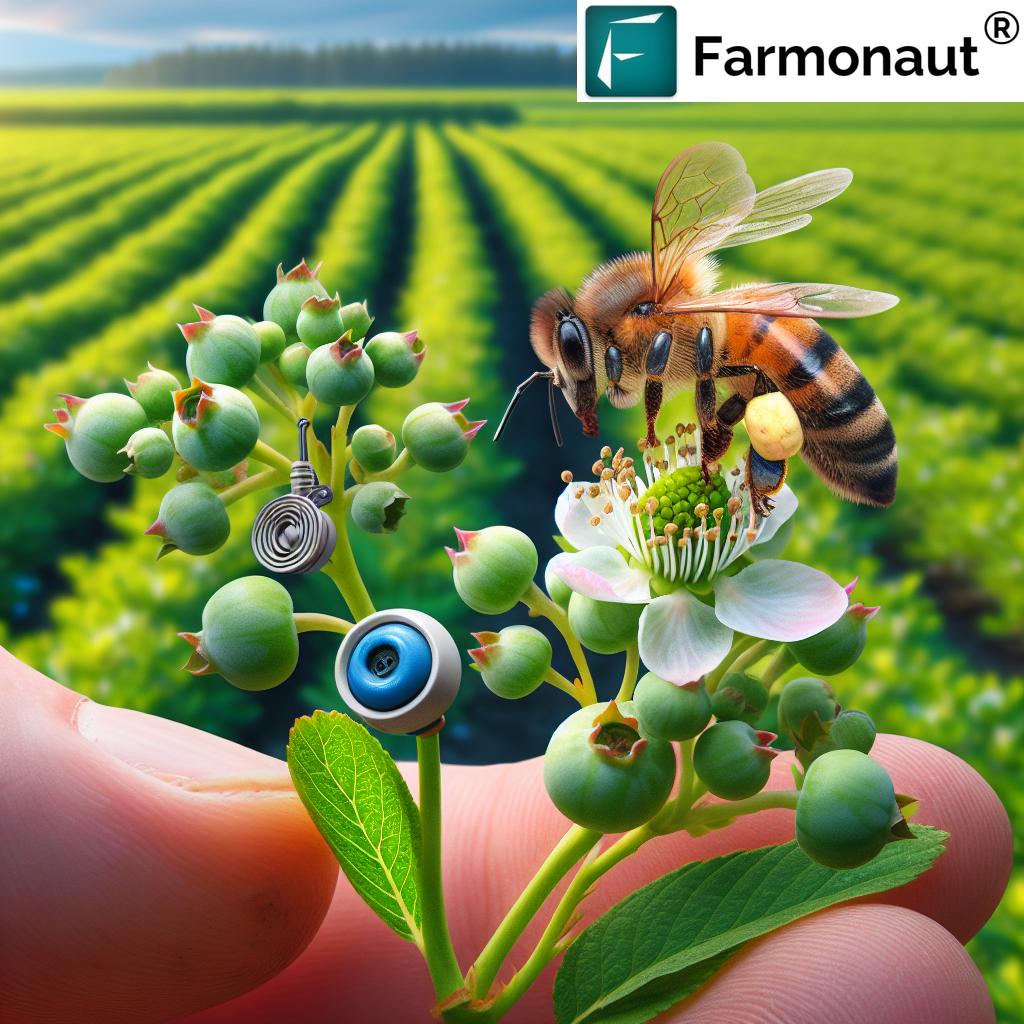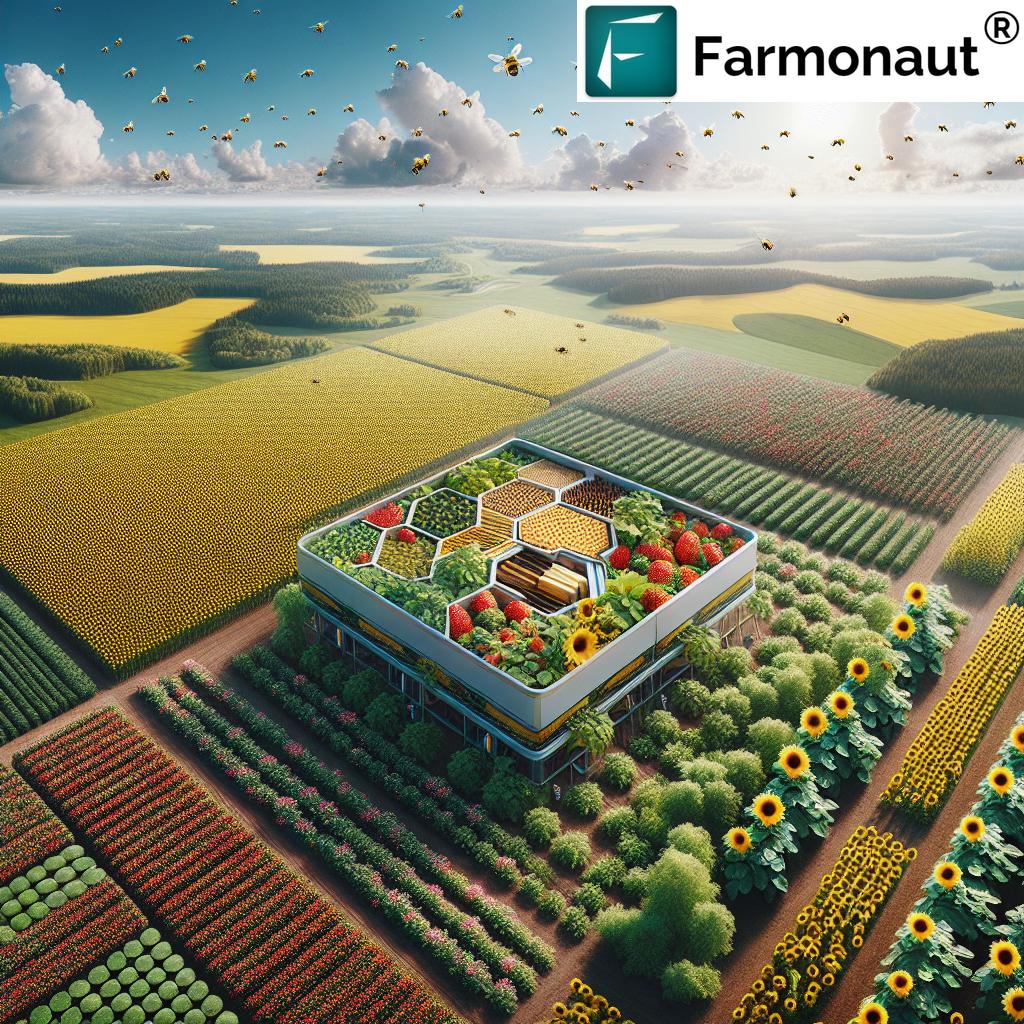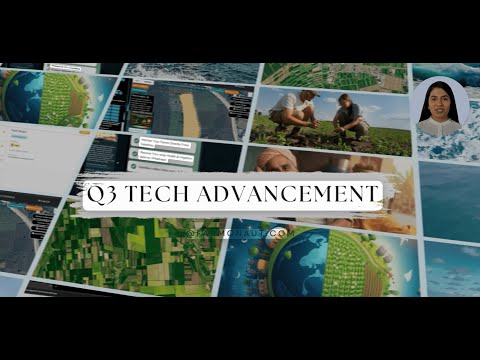Revolutionizing Sustainable Agriculture: How Bee Vectoring Technology is Transforming Crop Protection in Ontario
“EPA-approved bee vectoring technology can reduce chemical pesticide usage by up to 98% in certain crops.”
In the heart of Ontario, Canada, a revolutionary approach to sustainable farming practices is taking flight – quite literally. Bee vectoring technology is emerging as a game-changer in the world of agricultural pest management, offering an environmentally friendly crop protection solution that harnesses the power of nature’s most diligent workers: bees. As we delve into this innovative agriculture solution, we’ll explore how it’s transforming the landscape of precision agriculture and paving the way for a more sustainable future in food production.

Understanding Bee Vectoring Technology
Bee vectoring technology is an innovative approach that utilizes bees as natural carriers to deliver plant protection products directly to crops. This method combines the bees’ natural pollination behavior with targeted delivery of organic crop management solutions, offering a dual benefit of pollination and pest control. Here’s how it works:
- Specially formulated plant protection powders are placed in patented dispensers within beehives
- As bees exit the hive, they walk through these dispensers, picking up microscopic amounts of the powder on their bodies
- During their foraging flights, bees distribute the powder to flowers, providing precise, targeted delivery of crop protection agents
This eco-friendly pesticide alternative not only reduces the need for traditional chemical sprays but also supports beneficial insect populations, making it a cornerstone of sustainable farming practices.
The Impact on Ontario’s Agriculture
Ontario, with its diverse agricultural landscape, stands to benefit significantly from bee vectoring technology. From the sprawling blueberry fields to the vibrant strawberry patches, this innovative approach is reshaping how farmers manage their crops. Let’s explore the multifaceted impact:
- Reduced Chemical Usage: By leveraging bees for targeted delivery, farmers can dramatically reduce their reliance on broad-spectrum pesticides.
- Enhanced Pollination: The dual action of pollination and crop protection leads to improved yield and fruit quality.
- Support for Local Ecosystems: By minimizing chemical inputs, bee vectoring helps maintain healthy populations of beneficial insects and pollinators.
- Cost-Effective Solution: While initial setup costs may be higher, the long-term savings on pesticides and labor can be substantial.
As we continue to witness the positive outcomes of this technology, it’s clear that bee vectoring is not just a trend but a sustainable solution for the future of agriculture in Ontario and beyond.
Crops Benefiting from Bee Vectoring
The versatility of bee vectoring technology makes it applicable to a wide range of crops. In Ontario, several high-value crops are already seeing the benefits:
- Blueberries: Improved fruit set and reduced fungal diseases
- Strawberries: Enhanced pollination and protection against gray mold
- Sunflowers: Increased seed yield and oil content
- Apples: Better fruit quality and reduced incidence of storage rots
- Canola: Improved seed set and protection against sclerotinia
These crops represent just the beginning. As research continues, we expect to see bee vectoring technology adapted for use in an even broader range of agricultural products.
The Science Behind Bee Vectoring
At the core of bee vectoring technology is a deep understanding of bee behavior and plant biology. The active ingredients used in this method are carefully selected to be:
- Safe for bees and other pollinators
- Effective against target pests and diseases
- Compatible with the natural foraging behavior of bees
These biological control agents, often derived from naturally occurring fungi or bacteria, work in harmony with the plant’s defense mechanisms to ward off pests and pathogens. The precision of this delivery system ensures that the protective agents reach exactly where they’re needed – the blooms – without affecting non-target areas of the plant or surrounding environment.
Environmental Benefits and Sustainability
One of the most compelling aspects of bee vectoring technology is its alignment with sustainable farming practices. By reducing the need for chemical pesticides, this method offers numerous environmental benefits:
- Reduced Water Contamination: Less runoff from chemical sprays means cleaner waterways
- Soil Health Preservation: Minimized soil disturbance and reduced chemical residues in the soil
- Biodiversity Support: Creating a more hospitable environment for beneficial insects and wildlife
- Lower Carbon Footprint: Decreased use of machinery for pesticide application results in reduced fuel consumption
These environmental advantages position bee vectoring as a key player in the transition towards more sustainable food production technologies.

Economic Implications for Ontario Farmers
The adoption of bee vectoring technology presents a compelling economic case for Ontario’s agricultural sector:
- Reduced Input Costs: While initial investment may be higher, long-term savings on pesticides and application costs are significant
- Improved Crop Quality: Better pollination and targeted pest control lead to higher-quality produce that can command premium prices
- Labor Efficiency: Less time spent on pesticide application allows farmers to focus on other aspects of crop management
- Market Differentiation: Products grown using bee vectoring can be marketed as eco-friendly, potentially accessing new market segments
As the technology gains traction, we anticipate a positive ripple effect throughout Ontario’s agricultural economy, from individual farms to larger agribusinesses.
“Bee vectoring methods can increase crop yields by 20-30% while simultaneously providing pollination and pest control benefits.”
Regulatory Landscape and Approvals
The journey of bee vectoring technology from concept to field application has been marked by rigorous scientific testing and regulatory scrutiny. In Canada and the United States, regulatory bodies have recognized the potential of this innovative approach:
- EPA Approval: The U.S. Environmental Protection Agency has approved certain fungicides for application via bee vectoring
- PMRA Registration: Canada’s Pest Management Regulatory Agency is in the process of evaluating bee vectoring technologies
- Organic Certification: Many of the biological control agents used in bee vectoring are compatible with organic farming standards
These regulatory milestones are crucial in building trust among farmers and consumers, paving the way for wider adoption of bee vectoring technology.
Challenges and Future Directions
While bee vectoring technology shows immense promise, it’s not without its challenges. As we look to the future, several key areas require attention:
- Expanding Crop Compatibility: Research is ongoing to adapt the technology for use with a wider range of crops
- Optimizing Formulations: Continuously improving the active ingredients to enhance efficacy and ease of use
- Education and Adoption: Helping farmers understand and implement this new technology effectively
- Integration with Existing Practices: Finding ways to seamlessly incorporate bee vectoring into current farm management systems
Addressing these challenges will be crucial in realizing the full potential of bee vectoring technology across Ontario’s diverse agricultural landscape.
The Role of Technology in Modern Agriculture
As we embrace bee vectoring technology, it’s important to recognize its place within the broader context of agricultural innovation. Precision agriculture techniques are revolutionizing how we approach farming, and bee vectoring is just one piece of this exciting puzzle.
At Farmonaut, we’re at the forefront of this agricultural revolution, offering advanced satellite-based farm management solutions that complement innovative approaches like bee vectoring. Our platform provides real-time crop health monitoring, AI-based advisory systems, and resource management tools, all designed to make precision agriculture accessible and affordable for farmers worldwide.
Through our API, we offer developers and businesses the opportunity to integrate our satellite and weather data into their own systems, fostering collaboration and innovation in the agritech space. For those interested in leveraging our technology, our API Developer Docs provide comprehensive guidance.
Whether you’re managing a small farm or overseeing large-scale agricultural operations, Farmonaut’s solutions can help you make data-driven decisions to optimize your crop yields and resource management. Our platform is available as a web application, as well as mobile apps for both Android and iOS devices:
Comparative Analysis: Bee Vectoring vs. Traditional Pesticide Application
| Aspect | Bee Vectoring Technology | Traditional Pesticide Application |
|---|---|---|
| Application Method | Natural bee pollination patterns | Mechanical spraying or dusting |
| Environmental Impact | Minimal; supports ecosystem health | Higher risk of soil and water contamination |
| Pollination Benefit | Simultaneous pollination and pest control | No direct pollination benefit |
| Pest Control Efficacy | Targeted delivery to blooms | Broad coverage, including non-target areas |
| Cost-Effectiveness | Higher initial investment, lower long-term costs | Lower initial costs, higher ongoing expenses |
| Crop Compatibility | Ideal for flowering crops (e.g., berries, sunflowers) | Applicable to a wide range of crops |
| Chemical Usage | Reduced by up to 98% | Higher chemical usage |
| Beneficial Insect Impact | Supports beneficial insect populations | Can harm beneficial insects |
| Crop Yield Improvement | Estimated 20-30% increase | Variable, depending on application efficacy |
| Application Frequency | Continuous during flowering period | Multiple applications throughout growing season |
| Labor Requirements | Reduced after initial setup | Regular labor for application |
The Future of Sustainable Agriculture in Ontario
As we look to the future, it’s clear that bee vectoring technology will play a crucial role in shaping sustainable agriculture in Ontario and beyond. This innovative approach aligns perfectly with the growing demand for eco-friendly farming practices and the need to increase food production to meet global demands.
The integration of bee vectoring with other precision agriculture techniques, such as those offered by Farmonaut, presents exciting possibilities for holistic farm management. By combining real-time satellite data with targeted biological pest control, farmers can make more informed decisions, optimize resource use, and minimize environmental impact.
As research continues and adoption grows, we anticipate seeing:
- Expanded use of bee vectoring across a wider range of crops
- Further refinement of biological control agents for enhanced efficacy
- Integration with smart farming systems for data-driven decision making
- Increased consumer awareness and demand for products grown using sustainable methods
The future of agriculture in Ontario is one where technology and nature work in harmony, creating a more sustainable and productive farming landscape.
Conclusion
Bee vectoring technology represents a significant leap forward in our quest for sustainable farming practices. By harnessing the natural behavior of bees to deliver targeted crop protection, we’re not only reducing our reliance on chemical pesticides but also supporting the health of our ecosystems.
For Ontario’s farmers, this innovative approach offers a path to increased productivity, reduced costs, and improved environmental stewardship. As we continue to face challenges such as climate change and growing food demand, technologies like bee vectoring will be crucial in ensuring a sustainable and resilient agricultural future.
At Farmonaut, we’re committed to supporting this agricultural revolution by providing cutting-edge satellite-based farm management solutions. Our platform complements innovative approaches like bee vectoring, offering farmers the tools they need to make data-driven decisions and optimize their operations.
As we move forward, the integration of bee vectoring technology with other precision agriculture techniques will undoubtedly play a pivotal role in shaping the future of farming. It’s an exciting time for agriculture in Ontario and beyond, as we embrace technologies that work in harmony with nature to produce food more sustainably and efficiently than ever before.
FAQs
- What is bee vectoring technology?
Bee vectoring technology is an innovative method that uses bees to deliver targeted biological control agents to crops during pollination, offering a dual benefit of pest control and improved pollination. - How does bee vectoring reduce pesticide use?
By delivering targeted biological control agents directly to blooms, bee vectoring can reduce the need for broad-spectrum chemical pesticides by up to 98% in certain crops. - Which crops benefit most from bee vectoring?
Bee vectoring is particularly effective for flowering crops such as blueberries, strawberries, sunflowers, apples, and canola, but research is ongoing to expand its use to other crops. - Is bee vectoring technology approved for use in Canada?
While some bee vectoring products have been approved by the U.S. EPA, approval processes are ongoing with Canada’s Pest Management Regulatory Agency (PMRA). - How does bee vectoring technology impact beneficial insects?
Unlike traditional pesticides, bee vectoring supports beneficial insect populations by reducing the use of harmful chemicals in the environment. - What are the economic benefits of bee vectoring for farmers?
Farmers can benefit from reduced pesticide costs, improved crop yields (up to 20-30% increase), and potential premium pricing for eco-friendly produce. - How does Farmonaut support sustainable agriculture practices?
Farmonaut offers satellite-based farm management solutions that complement sustainable practices like bee vectoring by providing real-time crop health monitoring and AI-driven insights for optimized resource management. - Can bee vectoring be used in organic farming?
Yes, many of the biological control agents used in bee vectoring are compatible with organic farming standards, making it an attractive option for organic growers. - What challenges does bee vectoring technology face?
Challenges include expanding crop compatibility, optimizing formulations for different pests and diseases, and educating farmers on effective implementation. - How can farmers get started with bee vectoring technology?
Farmers interested in bee vectoring should consult with local agricultural extension services or bee vectoring technology providers to assess suitability for their specific crops and conditions.
Farmonaut Subscriptions






